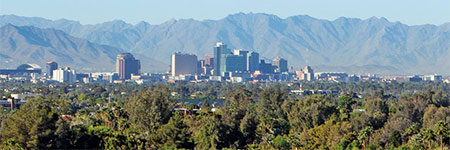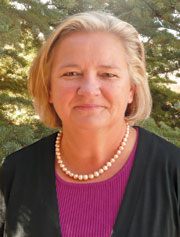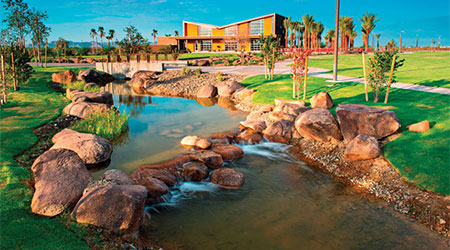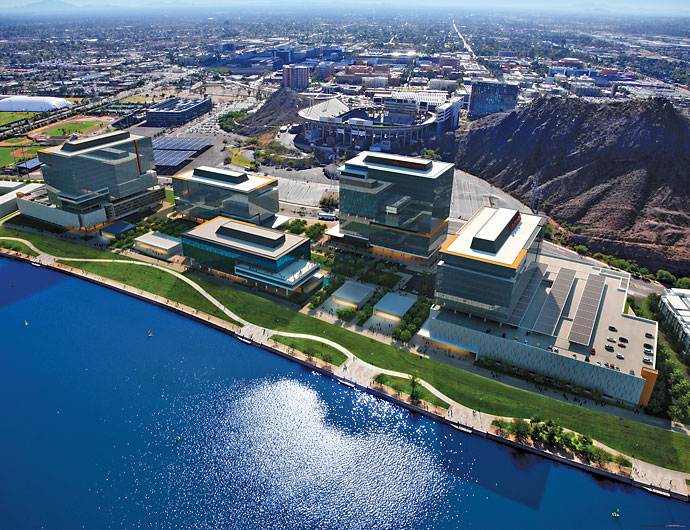Forging new collaborations between universities and corporate investors is the linchpin behind the new business growth strategy of the desert Southwest.
State Farm Insurance confirmed the wisdom of that strategy when it recently announced plans to develop a major corporate campus in Tempe, Ariz., adjacent to Arizona State University.
Construction began July 31 on the 2-million-sq.-ft. (185,800-sq.-m.) State Farm regional headquarters just north of ASU’s Sun Devil Stadium on the shore of Tempe Town Lake. The 20-acre (8-hectare), $600-million complex called Marina Heights is being developed by Ryan Companies and Scottsdale-based Sunbelt Holdings. Upon completion, it will be the largest office development in the history of Arizona.
The first 370,000-sq.-ft. (34,373-sq.-m.) building is slated to open by mid-2015. By 2018, five buildings will be on site and include office space, retail shops and a 10-acre (4-hectare) plaza.
ASU President Michael Crowe says the project represents the kind of collaboration that his university wants to foster in the surrounding community. It also signals that the race for talent has never been greater, as employers of choice take their operations directly to the top training grounds in America — the nation’s colleges and universities.
“The groundbreaking demonstrates our partnership with State Farm, who shares our strong commitment to education and the development of future generations,” said Crowe. “We look forward to opportunities to expand this partnership in new areas as advances in innovation and information technology provide opportunities for future programs.”
The new State Farm campus will provide claims, service and sales support to State Farm customers. Once completed, the complex is expected to have capacity for up to 8,000 employees.
Three-Hub Strategy Fulfilled
Phil Supple, director of public affairs for State Farm, says strong company growth made the expansion possible. “Coming off of one of our best growth years across product lines, State Farm is as financially strong as we’ve ever been as an organization,” he tells Site Selection. “From this position of strength, we continue to adapt — aligning our business with changing customer needs and expectations and adjusting to new technology changing the landscape of our business.”
The Tempe project fits into the company’s overall operating strategy, he adds. “We will utilize Phoenix, Dallas and Atlanta as multi-functional hubs, complemented by existing operations centers throughout the United States and Canada. Corporate headquarters will remain in Bloomington, Ill. The hubs will be staffed by a combination of new hires and existing employees who will perform a number of business operations to serve our customers. The expansion positions State Farm for the future.”
State Farm indicated that its site selection was driven by a need to find a location with a growing population, “including people with skill sets that match our customers’ needs,” according to Michael Jones, vice president of State Farm Administrative Services. Providing a “live-work-play environment” for employees is a key consideration, Jones noted.
Supple adds that “historically, it has not been State Farm’s practice to seek incentives. Instead, we would prefer that local governments invest those dollars back into the community.”
State Farm is not the only major corporation partnering with ASU on a business initiative. Mayo Clinic Ventures, based in Rochester, Minn., announced  Phoenix, Arizona Sept. 17 that it is joining Arizona Furnace, the startup accelerator at ASU that supports entrepreneurial teams using designated research discoveries and intellectual property as the basis for new companies.
Phoenix, Arizona Sept. 17 that it is joining Arizona Furnace, the startup accelerator at ASU that supports entrepreneurial teams using designated research discoveries and intellectual property as the basis for new companies.
As ASU and its partners prepare to launch the second application season for Arizona Furnace, Mayo Clinic will provide access to high-potential technologies in the clinic’s extensive intellectual property vault. These technologies, along with intellectual property from ASU, Northern Arizona University and Digital Health in Arizona, will be made available to entrepreneurs interested in using these discoveries to create products, services and companies.
“The goal is to create high-density districts that create collisions of entrepreneurs and investors.”
— Bob Frank, president of the University of New Mexico in Albuquerque
“This is a tremendous opportunity to have technologies conceived by Mayo Clinic staff vetted for startup opportunity potential through the Arizona Furnace,” says Jim Rogers, chair of Mayo Clinic Ventures. “We look forward to working together to shape the field of medicine for clinicians and ultimately for patients.”
A History of Collaboration
Rogers tells Site Selection that “ASU has engineering expertise. We have clinical and R&D expertise. Marrying those two can be very useful. We are doing the same sort of thing up here in Rochester, Minn., where Mayo Clinic is headquartered. From our perspective, we want to expose more of our technologies to a wider audience. These types of technologies may attract students and other researchers in the life-sciences field. It is a great win for both ASU and Mayo Clinic.”
Rogers says that Mayo Clinic’s existing practice in Scottsdale will support the ASU initiative. “We really enjoy the partnership we have with ASU,” he adds. “This is just one of many collaborations that we have had with the school.”
Gordon McConnell, assistant vice president for innovation, entrepreneurship and venture acceleration for the Office of Knowledge Enterprise Development at ASU, calls Arizona Furnace “the startup unit of the university. We basically work with all of the startups that come out of the university. We share space with the technology transfer office at ASU.”
He explains that once a startup is created, the technology transfer office hands the new firm off to Arizona Furnace. Based at Skysong Center, Furnace works seamlessly with an organization called Arizona Technology Enterprises.
McConnell adds that “we are very excited to have Mayo Clinic join us. They understand how good this program is for technology transfer offices, including their own.”
At Furnace, teams actually compete against each other to win backing by Furnace. Of the 22 teams that entered the first round of competition last year, 10 were chosen to become sponsored startups.

Lisa Kuuttila, CEO and chief economic development officer for STC.UNM
“We accelerate them, get them commercialized and get them talking to customers,” says Rogers. “By February, we will have a new number of teams coming out of here. Nobody has ever tried to do this before. We have been contacted by quite a number of institutions from other states and other countries. We will probably be running one in California and one in another southern state by this time next fall.”
The goal of the program is to make sure that the startup survives with a sustainable business model, notes Rogers. “Several of our Furnace startups are in talks with venture capital investors right now,” he says. “We also have more than 300 mentors who donate their time to Furnace.”
A university acting as a magnet for expanding companies is one thing. Communities vying for the right to win a major campus investment from an existing university is another.
That’s exactly what’s happened in the case of Grand Canyon University, a private Christian university that currently has 8,500 students enrolled at its main campus in Camelback.
On a fast growth track, GCU hired Colliers International to conduct a wide-ranging search for a second major campus site of 90 to 150 acres (36 to 61 hectares) in the US Southwest. Colliers circulated the detailed RFP to Albuquerque, Las Vegas, Tucson and multiple cities in the Greater Phoenix metropolitan area, including Chandler, Gilbert, Mesa, Queen Creek and Tempe.
“We put forth a list of 112 sites to the university,” says Todd Noel, senior vice president of Colliers. “We had preliminary meetings and invited the competing cities to come visit GCU’s existing campus. Once the sites were evaluated, we short-listed them and focused our attention on the Arizona cities between the East Valley and Southern Arizona. Since GCU has more than $150 million of development taking place on its Phoenix campus right now, it made the most sense to focus on Arizona first.”
GCU Selects East Valley Site

Eastmark is a master-planned community of DMB Associates in Mesa, Ariz., which won the competition to be the home of the new campus of Grand Canyon University.
Photo courtesy of Eastmark
The site search was both complex and exhaustive. Colliers and GCU looked at existing college enrollment numbers and detailed demographics in each prospective community. Proximity to retail, freeway access, major arterial roadways and essential infrastructure were vital, says Noel. “We considered the current landowners’ ability to convey and perform. Each site needed to be thoroughly vetted,” he notes. “Lack of a private Christian university in the area was a key factor. There are 75 of them in California. Boston has 15. Arizona has one, and New Mexico has none. When the list got shorter, we were able to focus on the East Valley.”
Colliers arranged multiple meetings with the competing East Valley cities. That process culminated on July 30 when GCU selected Eastmark, a 3,200-acre (1,296-hectare) mixed-use community in Mesa, for the college’s second campus.
The 12-month site search resulted in GCU securing the right to acquire 100 acres (40.5 hectares) in the DMB Associates master-planned community, with an option to purchase an additional 60 adjoining acres (24 hectares) for expansion in future years.
“In selecting the Eastmark site, we were especially impressed with the integrated community concept DMB is creating,” said Brian Mueller, president and CEO of GCU. “This environment will give our students, faculty and staff an exciting place to learn, work and play while being an integral part of the East Valley community. We believe our presence will benefit the entire region by providing the option of a low-cost, high-quality Christian education to all its residents.”
The City of Mesa celebrated winning the intense competition for the new GCU campus. “We are honored to welcome Grand Canyon University to Mesa, Arizona’s newest college town,” said Mesa Mayor Scott Smith. “We are looking forward to showcasing their university to potential students from around the region and the globe.”
The City of Mesa recently launched the “Mesa Educates U” marketing campaign to promote the community as a premier destination for higher education.
Having recently joined the Western Athletic Conference, GCU gives Mesa the presence and prestige of an NCAA Division I athletic program. GCU has also been building a national brand with a rapidly growing following, as its online program now counts some 49,000 students.
Founded in 1949, GCU is planning on a seven-year build-out of the campus that will include offices and administration space, classroom buildings, labs, student union facility, dorms, recreational fields and parking lots. Construction of the campus is expected to begin in 2014, with a potential opening date as early as 2015, pending legal and regulatory approvals.
Six Colleges Pick Mesa
When asked what set Eastmark apart from the other bids, Noel said it came down to the developer DMB’s “ability to perform.” Specifically, he said, “they have the financial wherewithal to perform. They have a strong commitment to retail, and they have been an outstanding partner throughout this process. That really sealed the deal.”
Noel says GCU liked the fact that there are no other comparable college campuses in Mesa. “Five smaller colleges are located there, but nothing like this,” says Noel. “GCU’s presence will be second to none in the East Valley.”
Upon build-out, GCU intends to have 800 employees and 7,500 students on its campus in Mesa, says Noel.
Interestingly, Mesa has attracted branch campuses of five other private colleges in the past five months. Benedictine University is the first to take up space in the downtown, with the other four schools initially planning a small presence as well.
Noel calls the GCU selection of Mesa a win-win deal. “This has been a phenomenal project to work on,” he says. “As a private, for-profit university, they will be paying taxes to the city and the state. There are compelling reasons to support this project from the municipal perspective.”
New Mexico is experiencing success with its own collaborations involving higher-education institutions.
At the University of New Mexico in Albuquerque, Innovate ABQ is being launched as a new program to expedite the commercial success of entrepreneurial startups.
Lisa Kuuttila, CEO and chief economic development officer for STC.UNM — the UNM Science and Technology Corp. — heads up Innovate ABQ. She says, “We are embarking on a project to really take our innovation ecosystem to the next level. We have really great science here. We have national labs like Sandia and Los Alamos, the university, the Air Force Research Lab, and a great creative community. We also have a lot of entrepreneurs. Many people are moving here simply because they love New Mexico.”
According to research conducted by STC.UNM, 40 percent of New Mexico CEOs are transplanted entrepreneurs. “They were successful in San Diego or San Francisco or San Jose or Boston or some other place and they decided to come here,” Kuuttila says. “An academic study looked at the entrepreneurial personality of regions, and we rank eighth in the country in our entrepreneurial behavior.”
